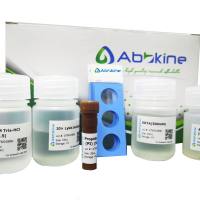UV Quantitation of DNA
互联网
|
|
DNA absorbs ultraviolet light due to its highly conjugated nature. DNA may thus be easily quantitated in a UV spectrometer.
Typically, 1 OD260 (i.e. a solution having an absorbance of one unit at 260 nm with a path length of 1 cm) is said to correspond to a concentration of 30-37 ug per ml. This is for single stranded DNA with an equal mixture of each of the four bases. RNA or double stranded DNA have values of 40 and 50 mg per ml, respectively.
For work with DNA longer than probes and primers, these assumptions are valid because the constituent bases are usually fairly evenly represented. With oligos, however, the base composition may be highly skewed. For instance, 1 OD of a sequence of all cytidines would correspond to 39.4 μg/ml and 1 OD of a sequence of all adenosites would correspond to 22.8 μg/ml.
Since the composition and sequence of the oligo are usually known, this information may be used to calculate individualized values for more accurate quantitation.
Equations
Values are calculated by either of two similar methods. The following equations is the simplest:
1. μg 1
-- = --------------------------------------------------
ml (15400A 7400C 11500G 8700T)
------------------------------
100undefined(312A 288C 328G 303T-61)
A, C, G, and T are simply the number of each base in the oligo. This equation simply averages the extinction coefficients (in L/mol-Table 1) of each base and divides by the molecular weight (g/mol).
|
Table 1. |
|
2. μg 1
-- = --------------------------------------------------
ml undefinedSum(Eab)-(E2 E3 ... E(n-2) E(n-1))
--------------------------------------
100undefined(312A 288C 328G 303T-61)
Where sum(Eab) is the sum of the pairwise extinction coefficients (Table 2) and the E values are the normal single extinction coefficients for each individual base. (Please note that the first and last bases' extinction coefficients, E1 and E2 , are not subtracted.) The pairwise values can be found in Table 2.
Both of these equations give good results. The difference between them is rarely more than a few μg per mil.
|
Table 2. |
Pairwise extinction coefficients |
|
|
|
|
3' Base |
||||
|
A |
C |
G |
T |
||
|
5' Base |
A |
13,700 |
10,600 |
12,500 |
11,400 |
|
C |
10,600 |
7,300 |
9,000 |
7,600 |
|
|
G |
12,600 |
8,800 |
10,800 |
10,000 |
|
|
T |
11,700 |
8,100 |
9,500 |
8,400 |
Examples
For the sequence AGAG, equation (1) gives:
Equation 1 Gives:
μg 1
-- = --------------------------------------------------
ml (1540undefined2 1150undefined2)
---------------------
100undefined(31undefined2 32undefined2-61)
= 22.7
Equation 2 Gives:
μg 1
-- = --------------------------------------------------
ml 2(12500 12600 12500)-(11500 15400)
---------------------------------------
100undefined(31undefined2 32undefined2-61)
= 25.4
Conclusion
In our example, the results are similar to each other and quite different from the all-purpose value of 30 mg/ml. The degree of accuracy offered by the above equations may not be needed in normal circumstances. Where highly precise quantitation is required, they will yield excellent results.
Sigma-Genosys Guaranteed Yields
Please see the Sigma-Genosys Yields tech sheet for a listing of the yield guarantee for various oligos ordered from Sigma-Genosys.









